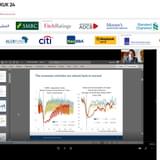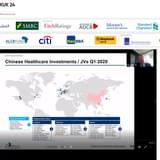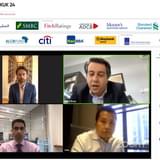Capital outflows from China increased to US$113bn in Q3 2016, up by US$14bn on Q2 2016, as a strengthening US dollar and concerns over global trade continue to take a toll on the renminbi, spooking investors.
“The biggest decline in the value of China’s foreign exchange reserves since the start of the year has more to do with movements in exchange rates and asset prices than sales by the People’s Bank,” claimed Capital Economics’ China economist Julian Evans-Pritchard in a recent report.
While the People’s Bank of China’s secretive approach about its reserves and FX intervention volumes makes it notoriously difficult to assess the true scale of the exodus of capital, analyses of the situation by a number of observers show they are united in highlighting concerns about rising capital outflows.
There is broad agreement that the drop in FX reserves in October topped US$45bn – the biggest decline since the beginning of 2016. Around US$3.12tn worth of FX reserves remain.
Part of that fall is attributed to the gradual readjustment of the exchange rate, as the US dollar strengthened and global bond prices fell.
“One of the reasons for capital flight is the very covered way in which China is devaluing the renminbi, with investors in the region worrying about how far that can go,” said Greg Saichin, Chief Investment Officer, Global Emerging Markets Fixed Income at Allianz Global Investors.
According to a recent IIF report, the devaluation stripped almost US$30bn of the total value of FX reserves – however this figure has since been revised downwards.
Although intentionally letting its currency depreciate, the PBOC is intervening to prevent any out of control fall. Both IIF and Capital Economics data suggests that the PBOC sold around US$16bn to prop up the yuan in October – although this is down from sales the previous month, which the IIF placed at US$23bn.
Uncertainty over the PBOC’s policies has led to a month-on-month decline in capital outflows. The IIF noted that net losses, although down from US$90bn in September, still amounted to US$73bn in October.
Although this is still less than the end of 2015 and start of 2016 figures, when monthly losses reached US$120bn, the numbers are still worryingly elevated, having accelerated in the third quarter.
The IIF report claims that Q3 2016 outflows, at US$207bn, were the highest quarterly outflows year-on-year. Year-to-date net outflows reached US$540bn.
Another reason for the high outflows is the lack of profit-making opportunities in Chinese assets.
Recently, the yield on the benchmark 10-year bonds rose 1bp this month to 2.779%, the longer dated 30-year bond yield climbed 1bp 3.213% and the yield on 7-year bonds gained 1.5bp to 2.755%, according to Reuters.
Simultaneously, inflation has been speeding up, with consumer prices rising by 2.1% year-on-year in October.
“China appears to pursue a strategy of depreciating the CNY to some degree (2-4% potentially in 2017) to provide a more competitive currency to exporters. For domestic investors, the prospect of seeing depreciation outpacing nominal yields (10-year government bonds at 2.7%) makes buying US dollars appealing, thus accelerating the loss of currency reserves,” Saichin explained.
“If the Chinese economy is cooling more rapidly than suggested, that will heavily influence the perception of returns that an investor can obtain from domestic assets, be it real or financial, making US dollar-denominated assets more appealing,” he added.
Some have moved their funds to Hong Kong, looking to buy foreign-currency-denominated insurance products. Others invest in cryptocurrencies – China is now the largest holder of Bitcoin in the world.
“Given China’s dominance in Bitcoin trading, regulators are now preparing to regulate these transactions more strictly to curb capital flight that relies on Bitcoin as a tool to avoid Chinese capital controls,” the IIF report stated.
On a corporate level, the larger manufacturing companies are slow to convert the dollar earnings from their exports into yuan, instead choosing to hedge against further decline in the yuan through derivatives contracts.
“This is a serious problem for China, as the reserves are being depleted. The currency is depreciating and money is leaving the country, so alarm bells are ringing.”
The Chinese government uses various instruments at its disposal to bring outflows under control. For example, it acted to curtail cross-border transactions by companies and limit the amount of foreign currency individuals can buy.
The PBOC also introduced an exchange-rate-setting mechanism that gives the Central Bank more control over the yuan’s price.
But these measures are unlikely to have any substantial effects as long as the government’s ultimate aim is to further devalue the currency, as it continues the painful transition from a manufacturing to a consumer and service economy.
“China is undergoing a well-understood process whereby its economy is maturing, becoming more sophisticated. It is fine so long as the process is controlled, but if you see continued cash outflows quarter-to-quarter, it means there is a problem,” Saichin said, warning that further shocks, such as unpredictability of the US’s new administration in terms of trade policies or a Fed rate hike, could exacerbate the situation further. “At the moment, investors are worried,” he concluded.
The renminbi weakened 1.5% against the dollar in October, but remained fairly stable relative to the CFETC basket.
“This suggests that capital outflows in October were primarily triggered by the overall strength in the US dollar,” the IIF report indicated.
In the upcoming months, this tendency is unlikely to change – although outflows could slow down if the US dollar begins to slide due to a ‘Trump-effect’. But if the current exchange rate dynamic is maintained, further capital outflows could put the Chinese policy makers in a tricky position.
“Looking ahead, the PBOC could choose to intervene to stabilise the renminbi against the dollar but it would have to accept renewed trade-weighted renminbi appreciation, a price that it has so far been reluctant to pay,” the Capital Economics report concluded.
If the authorities are not careful, a quickly developing feedback loop between a falling currency and capital drain could snowball the economy from under their control.









